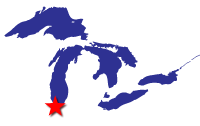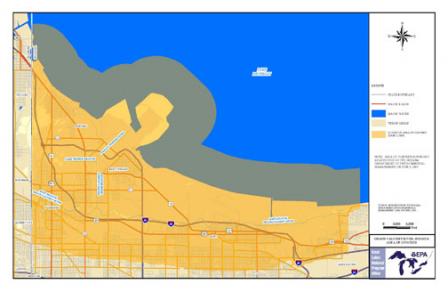Grand Calumet River AOC
Contact Us
Kristen Isom
(isom.kristen@epa.gov)
312-353-6318
On this page:
- Latest News
- Overview
- Beneficial Use Impairments
- Remediation and Restoration Work
- Highlighted Projects
- Partners
Latest News
- EPA announces $26 million cleanup of Grand Calumet River in Northwest Indiana
- Great Lakes Initiative Cleanup Helps Restore Grand Calumet River
- Restored Grand Calumet River is a learning spot for local educators Exit
Overview
The Grand Calumet River is in one of the most heavily industrialized areas in the United States, flowing mainly through northwestern Indiana. Beginning in the 20th century the area began experiencing an influx of steel mills, foundries, chemical plants, oil refineries, meat packing industries, and pharmaceutical industries. Prior to the 1972 Clean Water Act, industries released industrial waste and some nearby cities discharged untreated sewage into the river. In addition, potential nonpoint sources of contaminants, such as industrial and urban runoff may have affected water quality in the river.
The river was designated as an Area of Concern (AOC) under the Great Lakes Water Quality Agreement of 1987, largely due to legacy pollutants. These pollutants remain in the environment for extended periods of time after they are introduced and were found in sediments at the bottom of the Grand Calumet River, Indiana Harbor and Ship Canal. These legacy pollutants include:
- Polychlorinated biphenyls (PCBs)
- Polycyclic aromatic hydrocarbons (PAHs) (PDF)(2 pp, 2013 142 K, About PDF)
- Heavy metals including but not limited to mercury, cadmium, chromium, and lead
- Oil and grease
The Grand Calumet River originates on the east side of Gary, Ind., and is comprised of two east-west flowing branches that cover the southern end of the Indiana Harbor Ship Canal. The eastern branch of the river drains into Lake Michigan. The AOC area, which is 22 square miles in total, encompasses portions of the cities of Gary, East Chicago, Hammond, and Whiting, Ind., and is defined by:
- The Indiana/Illinois state line to the west
- Grand Avenue around Marquette Park lagoons in Gary to the east
- The southern boundary extending to the Tolleston Beach Ridge
- The northern boundary on Lake Michigan which includes a 1.5-mile buffer out into the lake
Beneficial Use Impairments
The Grand Calumet River has all 14 Beneficial Use Impairments. Beneficial Use Impairments are designations created by the International Joint Commission that identify some of the most severe examples of environmental degradation. When restoration or cleanup projects begin to make progress, monitoring of the site will eventually show sufficient improvement in environmental health. Once a BUI reaches this point, it can be “removed”, or the beneficial use is restored. So far, two BUIs, Restrictions on Drinking Water Consumption, or Taste and Odor Problems and Added Costs to Agriculture or Industry have been removed. Once the remaining 12 BUIs have been removed, EPA and the state of Indiana can begin the process of delisting.
- Restrictions on Fish and Wildlife Consumption
- Eutrophication or Undesirable Algae
- Tainting of Fish and Wildlife Flavor
- Restrictions on Drinking Water Consumption, or Taste and Odor Problems (PDF) - Removed 2012
- Degradation of Fish and Wildlife Populations
- Beach Closings
- Fish Tumors or Other Deformities
- Degradation of Aesthetics
- Bird or Animal Deformities or Reproduction Problems
- Added Costs to Agriculture or Industry (PDF) - Removed 2011
- Degradation of Benthos
- Degradation of Phytoplankton and Zooplankton Populations
- Restriction on Dredging Activities
- Loss of Fish and Wildlife Habitat
- On the status of each BUI for this AOC, see the Update to the Grand Calumet River/Indiana Harbor Ship Canal AOC Stage 2.5 Remedial Action Plan Exit
- General information about BUIs: Beneficial Use Impairments for the Great Lakes AOCs
Remediation and Restoration Work
EPA works with federal, state and local partners to implement remediation and restoration projects in the Grand Calumet River AOC. The overall goal is to remove the river’s designation as an AOC.
- Documents on Restoring the Grand Calumet River AOC
- View Remediation and Restoration Projects for this AOC
In order to delist the Grand Calumet River AOC, EPA and partners identified 12 sediment remediation and five habitat restoration projects or management actions. Of the 12 sediment remediation projects, five have already been completed and three are underway. The goal of sediment remediation is to address sediments contaminated severely with PCBs, PAHs, and heavy metals. Sediment may be addressed by dredging and/or capping to prevent further release of contaminants.
Habitat in the AOC had lost functionality due to urbanization and habitat destruction. Four of five habitat projects are currently underway. EPA and partners have implemented habitat restoration projects involving prescribed burns, reestablishing native species, and restoring globally rare dune and swale habitats. To delist this AOC, partners must meet habitat-related BUI removal criteria (PDF). Exit Restoration and cleanup at this AOC will improve one of the most heavily polluted areas in the Great Lakes watershed and allow the surrounding communities to benefit more fully from the river and surrounding ecosystems.
More information:
- On remediation actions for legacy contaminants, see Legacy Act Cleanup of Grand Calumet River.
- On project disposal of contaminated sediments in East Chicago, Ind., see Indiana Harbor Canal.
Highlighted Projects
Great Lakes Legacy Act — Stateline Remedial Action
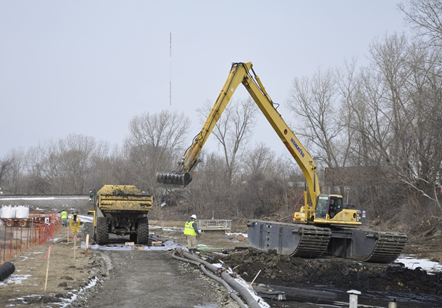 Dredging during the GLLA Stateline Remedial Action project.
Dredging during the GLLA Stateline Remedial Action project.
The Stateline Remedial Action Great Lakes Legacy Act (GLLA) project was completed in 2016. Through a successful partnership between EPA, Indiana Department of Natural Resources, Indiana Department of Environmental Management, and Northern Indiana Public Service Company, the project removed approximately 14,600 cubic yards of contaminated sediment containing heavy metals, PAHs, and PCBs, from the river in a 0.4-mile stretch located between the Illinois-Indiana state line and Hohman Avenue in Hammond.
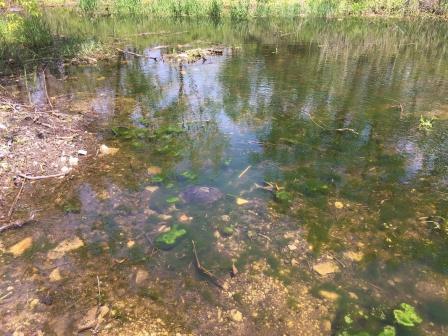 Clean habitat created by the Stateline Remedial Action Project helps support wildlife, such as the turtle pictured here. Credit: Great Lakes Mud.A cap, which provides clean habitat for benthic—or sediment-dwelling organisms, was also used to contain another 30,000 cubic yards of sediment. The project also removed invasive plant species and planted native shrubs and trees. Overall benefits of this project include healthier benthos, reduced contaminant exposure to fish, more abundant fish and wildlife habitat, and improved aesthetics.
Clean habitat created by the Stateline Remedial Action Project helps support wildlife, such as the turtle pictured here. Credit: Great Lakes Mud.A cap, which provides clean habitat for benthic—or sediment-dwelling organisms, was also used to contain another 30,000 cubic yards of sediment. The project also removed invasive plant species and planted native shrubs and trees. Overall benefits of this project include healthier benthos, reduced contaminant exposure to fish, more abundant fish and wildlife habitat, and improved aesthetics.
More Information:
- On work done for the GLLA Stateline Remedial Action Project, visit Great Lakes Mud.Exit
Dune, Swale and Shelf Wetlands Restoration
 Map of areas within the Grand Calumet River AOC in which the Dune, Swale, and Shelf Wetlands Restoration project was implemented. Credit: Indiana Department of Environmental Management (IDEM).
Map of areas within the Grand Calumet River AOC in which the Dune, Swale, and Shelf Wetlands Restoration project was implemented. Credit: Indiana Department of Environmental Management (IDEM).
In partnership with the Indiana Department of Environmental Management, the Indiana Department of Natural Resources, the Nature Conservancy, and the Lake County Parks and Recreation Department, the GLRI-funded Dune and Swale Wetlands Restoration project is restoring dune, swale, and shelf wetland habitat — a globally rare habitat. The habitat is home to many important species such as the Karner blue butterfly, Blanding’s turtle, spotted turtle, and various migratory birds.
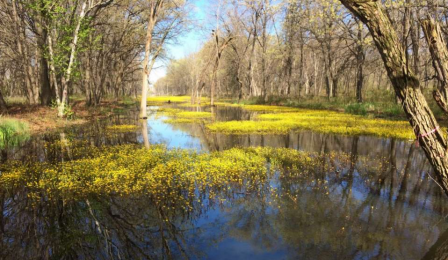 Gibson Woods Nature Preserve in northwest Indiana is part of the Dune, Swale, and Shelf Wetlands Restoration project. Credit: IDEM.The project, which began in 2015, will restore at least 900 acres of state- and locally- managed habitat throughout 15 sites in the Grand Calumet AOC. It is anticipated that this work will be completed by 2021. The project’s main objective is to control dense areas of woody and herbaceous (non-woody) nuisance and invasive plant species such as phragmites. Controlling these invasive species will improve the structure and quality of dune, swale, and shelf wetland habitat and benefit native species, leading to increased fish and wildlife populations in the AOC.
Gibson Woods Nature Preserve in northwest Indiana is part of the Dune, Swale, and Shelf Wetlands Restoration project. Credit: IDEM.The project, which began in 2015, will restore at least 900 acres of state- and locally- managed habitat throughout 15 sites in the Grand Calumet AOC. It is anticipated that this work will be completed by 2021. The project’s main objective is to control dense areas of woody and herbaceous (non-woody) nuisance and invasive plant species such as phragmites. Controlling these invasive species will improve the structure and quality of dune, swale, and shelf wetland habitat and benefit native species, leading to increased fish and wildlife populations in the AOC.
This project addresses the below BUIs:
- Degradation of Fish and Wildlife Populations
- Loss of Fish and Wildlife Habitat
Partners
The following links exit the site ExIT
- Citizen's Advisory for the Remediation of the Environment Committee
- East Chicago Waterway Management District
- Grand Calumet River Restoration Fund Council
- Indiana Department of Environmental Management
- Indiana Department of Natural Resources
Other Partners for the Grand Calumet River
- Atlantic Richfield - British Petroleum
- Lake County Parks and Recreation Department
- Northern Indiana Public Service Company

